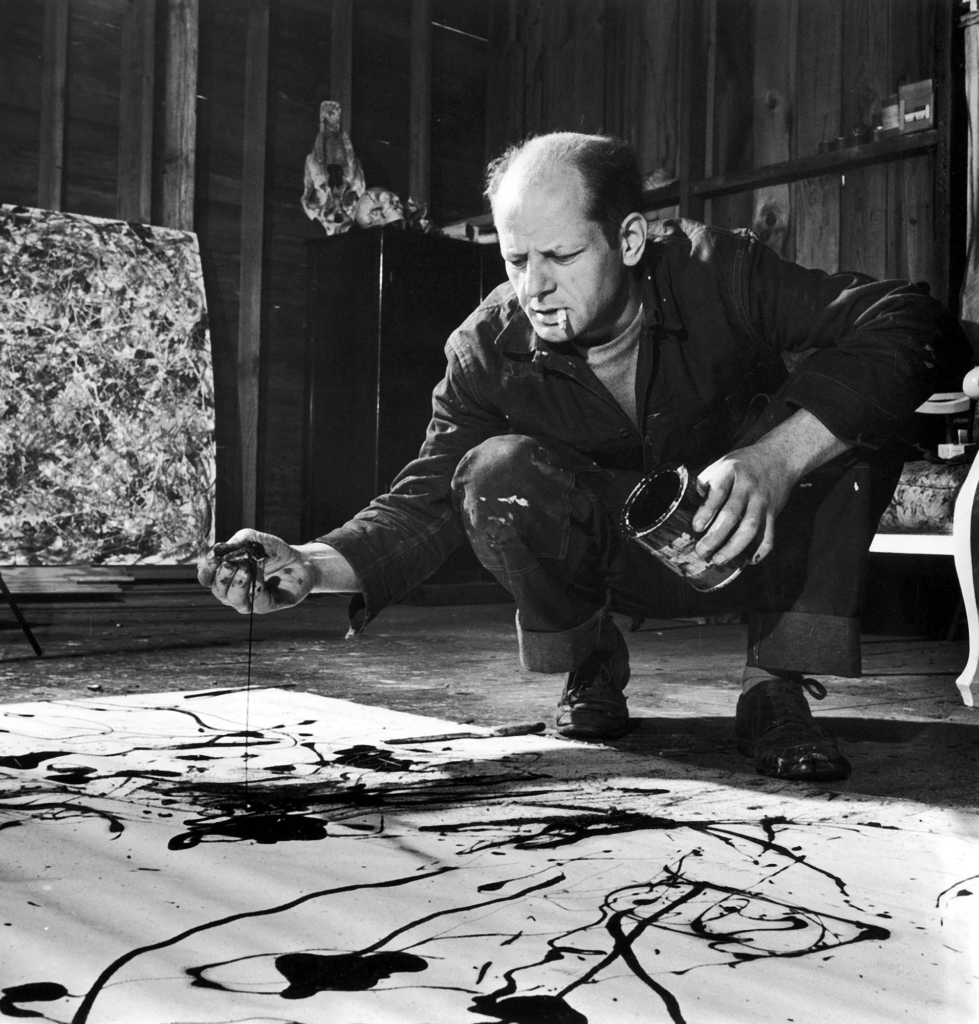Jackson Pollock Biography

Early Life and Education
Jackson Pollock, one of the most influential American artists of the 20th century, had a unique upbringing and educational background that significantly shaped his artistic style. Pollock was born in Cody in 1912 and spent his formative years in the American West. Growing up surrounded by nature and Native American culture, Pollock developed a deep appreciation for the natural world and its relation to art.
Pollock’s early education was quite unconventional. He attended several small schools before eventually enrolling in the Manual Arts High School Los Angeles. It was here that his talent for art began to flourish. Pollock studied under the guidance of Frederick John de St. Vrain Schwankovsky, a teacher who recognized his potential and encouraged him to pursue an art career.
After graduating high school, Pollock attended the Art Students League of New York. This renowned institution gave him the technical skills and artistic foundation to develop his unique style further. Under the tutelage of influential artists such as Thomas Hart Benton and Regionalist painter David Alfaro Siqueiros, Pollock honed his skills and experimented with various painting techniques.
Throughout his education, Pollock was exposed to various artistic influences, from traditional European styles to the emerging abstract expressionist movement. These influences, combined with his own experiences and observations of the natural world, would later inform his groundbreaking drip painting technique for which he is most famous.
What is Jackson Pollock known for?

Jackson Pollock is famous for his unique and influential style of abstract expressionism. His paintings, characterized by their use of dripping and pouring paint onto the canvas, revolutionized the art world and challenged traditional notions of what constitutes art.
Pollock’s work is known for its energy, spontaneity, and emotional intensity. His paintings often evoke a sense of movement and chaos, capturing the essence of the human experience. Pollock’s fame also stems from the controversy surrounding his work. While some critics and art enthusiasts praised his innovative approach, others dismissed it as a mere gimmick or a hoax.
Despite the mixed reception, Pollock’s paintings continue to captivate audiences and inspire artists today. His contributions to the art world have earned him a lasting legacy as one of the most influential artists of the 20th century.
Career highlights

What did Jackson Pollock invent?
Jackson Pollock was a renowned American painter known for his unique style of painting known as “drip painting” or “action painting.”
What technique did Jackson Pollock use?
Instead of traditional brushes, Pollock would pour or drip paint onto the canvas, allowing it to flow and splatter unpredictably.
He would often work on large canvases on the floor, allowing him to move around and apply paint from all angles freely. Pollock believed in “unconscious creation,” allowing his emotions and intuition to guide his movements and paint placement.
This technique allowed him to create dynamic and energetic compositions characterized by their abstract and chaotic appearance. Pollock’s innovative approach to painting had a significant impact on abstract expressionism.
What was Jackson Pollock’s most famous painting called?
Jackson Pollock’s most famous painting is called “No. 5, 1948.” It is an abstract expressionist piece that features intricate layers of dripped and poured paint. This painting is significant because it embodies Pollock’s unique style and technique, known as “drip painting.”
Why is Jackson Pollock important to painting?
Jackson Pollock is essential to painting for several reasons. First, he was a crucial figure in the abstract expressionist movement, which had a significant impact on the art world in the mid-20th century. His exceptional technique of dripping and pouring paint onto canvas challenged traditional notions of painting and expanded the boundaries of what art could be.
Additionally, Pollock’s work shifted towards non-representational art, focusing on creating an emotional expression rather than depicting recognizable subjects. It brought a new level of freedom and experimentation to the art world.
Pollock’s paintings also inspired future generations of artists, influencing the development of action painting and performance art. His bold and energetic style continues to captivate audiences and remains influential in contemporary art.
Jackson Pollock List of Work

What type of art is Pollock?
Modern Art
Expressionism
Action Painting
Notable Artworks
Convergence | 1952 |
Mural | 1943 |
Blue Poles | 1952 |
Full Fathom Five | 1947 |
The Deep | 1953 |
Moon Woman | 1942 |
Greyed Rainbow | 1953 |
Free Form | 1946 |
Number 32 | 1950 |
Untitled | 1944 |
The Tea Cup | 1946 |
What media did Jackson Pollock use?
Painting
Sculpture
Major Exhibitions
Jackson Pollock, one of the most influential American artists of the 20th century, had numerous major exhibitions and received several accolades throughout his career.
Museum of Modern Art (MoMA) in New York | 1943 | This exhibition, titled “Exhibition by 31 Women,” showcased works by female artists, including Pollock’s paintings. It was during this exhibition that Pollock first gained recognition for his abstract expressionism, characterized by his signature drip painting technique. |
Betty Parsons Gallery in New York | 1950 | This exhibition featured some of his iconic drip paintings, such as “Autumn Rhythm” and “Number 1A.” |
Venice Biennale | 1950 | He was invited to represent the United States and other prominent American artists. His large-scale painting “Alchemy” was showcased at the exhibition and received critical acclaim. |
MoMA | 1954 | Titled “Jackson Pollock: A Retrospective,” this exhibition showcased over 50 of his paintings and drawings spanning his entire career. It was a significant milestone for Pollock and solidified his status as a pioneering figure in contemporary art. |
Achievements
Throughout his career, Pollock received numerous accolades for his contributions to the art world. In 1950, he won the prestigious Guggenheim International Award, which recognized his innovative approach to painting. He was also awarded a grant from the Solomon R. Guggenheim Foundation in 1952, which allowed him to focus on his artistic practice.
Despite his untimely death in 1956, Pollock’s legacy continues to be celebrated through exhibitions of his work. Collectors highly seek after his paintings and continue to inspire artists worldwide.
Why did Pollock use enamel paint?
In terms of why Pollock used enamel paint specifically, there are a few reasons. Enamel paint dries quickly, allowing Pollock to layer and build up multiple layers of color in a short amount of time. It also created a smooth, glossy finish that added depth and texture to his paintings. Additionally, enamel paint allowed Pollock to achieve the vibrant, bold colors he desired for his artwork.
Who inspired Jackson Pollock to paint?
The inspiration for Jackson Pollock’s painting style and techniques can be attributed to several sources. One of the most significant influences on Pollock’s work was his mentor, Thomas Hart Benton, an American Regionalist painter. Benton emphasized the importance of storytelling and narrative in art, which had a profound impact on Pollock’s approach to painting.
Another significant influence on Pollock was Mexican muralist David Alfaro Siqueiros. Siqueiros introduced Pollock to using unconventional materials and techniques in his artwork, such as dripping and pouring paint onto the canvas. This experimental approach to painting became a defining characteristic of Pollock’s style.
Follow Jackson Pollock on social media
Instagram: https://www.instagram.com/jacksonpollock_official/?hl=en
Twitter: https://twitter.com/artistpollock?ref_src=twsrc%5Egoogle%7Ctwcamp%5Eserp%7Ctwgr%5Eauthor
